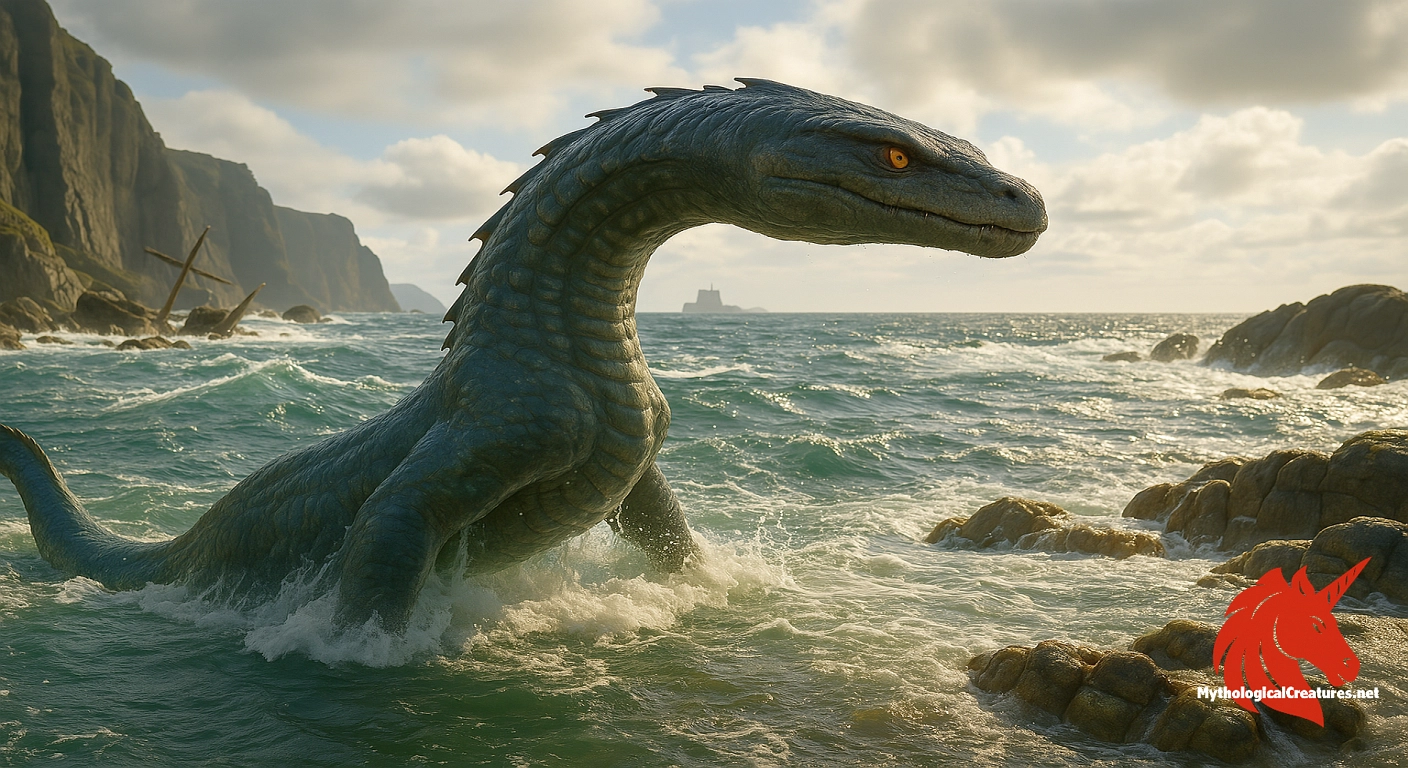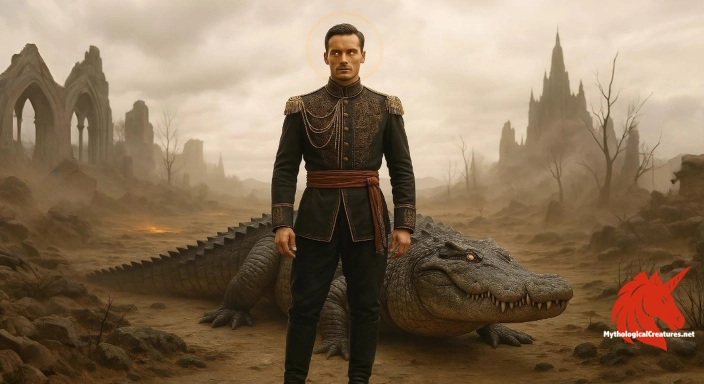Sea monster: Sea monsters are legendary creatures that inhabit deep ocean waters.

Sea monster
Sea monster - They symbolise the mystery and danger of the ocean's unexplored depths.
Origins & First Encounters
Sea monsters have long ignited the imagination of those who brave the vast, unpredictable oceans. Their legends originate from ancient maritime cultures where the shimmering, mysterious depths inspired both wonder and apprehension. Early seafarers, venturing into uncharted waters, reported encounters with colossal creatures that defied explanation and reason. Tales of these beings soon became interwoven with local lore, reflecting the awe inspired by nature’s hidden realms. Historic records indicate that even the earliest civilizations sought to explain the anomalies observed in the deep sea. These legendary beasts have been portrayed as both ominous warnings and embodiments of the ocean's untamed power. Over time, the narratives surrounding these creatures have evolved, mirroring humanity's changing relationship with the natural world. The enduring influence of these myths serves as a reminder of the mysteries that lie beneath the surface, continuously captivating modern audiences with ancient secrets. The sea monster remains a potent symbol in cultural memory, bridging the gap between historical myth and contemporary fascination. Its mythic presence challenges our understanding of the natural world and invites us to ponder the boundaries between legend and reality.
Source Texts & Tale Variants
Maritime chronicles and ancient texts offer a rich tapestry of accounts that bring sea monsters to life through vivid detail and allegory. Classical literature, including works by ancient scholars, provides some of the earliest written attestations, blending observation with imaginative embellishment. Diverse narratives appear in medieval bestiaries and navigational logs that mix natural history with folklore, creating a multifaceted perspective on these enigmatic beings. Oral traditions, passed down through generations of seafarers, have contributed colourful variations that reflect cultural contexts and local experiences. Nordic sagas, Mediterranean lore, and Eastern mythologies have each shaped distinct story variants, portraying sea monsters as both formidable adversaries and enigmatic guardians. Various ancient maps even incorporated depictions of these creatures, symbolising the mysterious and often treacherous nature of the sea. Documented sightings, though rare and heavily interpreted, have enriched the narrative fabric with anecdotal details that blur the line between myth and reality. Through the evolution of these sources, one can discern how merging empirical encounters with creative storytelling has forged an enduring mythology. The multiplicity of accounts underscores the universal human impulse to explain the unknown, rendering these legends a blend of cultural memory and imaginative invention. As new interpretations continue to emerge, the legacy of these primary sources offers an invaluable window into the fears and fascinations of past mariners.
Form & Powers
Descriptions of sea monsters span a wide spectrum, often encompassing elements drawn from reptiles, dragons, and giant cephalopods. Their physical forms are frequently depicted as sinuous and elongated, twisting gracefully through the water with an almost fluid dynamism. Detailed illustrations from various periods suggest that these creatures possess rugged scales that shimmer with dark, iridescent hues reminiscent of deep ocean colours. Some accounts emphasise a formidable array of tentacles, which undulate with an eerie, deliberate grace, hinting at both strength and mystery. The anatomy of these beasts is often marked by disproportionate features; enormous eyes that glow in the murky depths, and massive, gaping maws lined with rows of jagged teeth. In certain traditions, they are portrayed with multiple limbs or heads, each evoking an otherworldly sense of menace. Variations in size abound, with some portrayals likening them to colossal whales while others describe more serpentine, sinuous forms. Artistic renditions have captured these creatures with astonishing detail, from frilled fins and ornamental spines to bioluminescent markings that trace along their bodies. The fusion of reptilian and aquatic characteristics has made each depiction uniquely compelling, preserving the myth through layers of sensory imagery. Such elaborate physical descriptions underscore the inherent tension between beauty and danger, a hallmark of these legendary beings.
Regional Faces
Cultural interpretations of sea monsters vary considerably from one region to another, infusing each narrative with a distinct local colour. In the folklore of Northern Europe, these creatures are often envisioned as enormous sea serpents or the fearsome Kraken, lurking beneath stormy waters and emerging at the most inopportune moments. Mediterranean traditions tend to evoke images of draconic beings with scaly exteriors, ascribed with both protective and destructive powers along ancient coastlines. East Asian legends, by contrast, frequently translate sea monsters into majestic sea dragons, whose presence is intertwined with the balance of nature and even revered in ritual ceremonies. Indigenous communities along the coasts of the Americas have woven their local environmental features into tales of colossal aquatic guardians, navigating the boundaries between myth and nature. In parts of Africa, the mysteries of the sea are narrated as encounters with enigmatic spirits that embody both creation and annihilation. These regional variations not only reflect the natural landscapes and maritime traditions of different locales but also serve as cultural metaphors for the unpredictable forces of the ocean. The local embellishments, from distinctive markings to unique behavioural traits, mark the sea monster as a multifaceted symbol that adapts to its cultural milieu. Each narrative provides insight into the community’s relationship with the sea, embodying both reverence and caution. These adaptations demonstrate how a single mythical archetype can evolve into a diverse array of legends, each resonant with its own historical and ecological context.
Cultural Parallels
Sea monsters share fascinating similarities with other mythological creatures found across a variety of cultural landscapes, thereby highlighting universal themes of mystery and the sublime. The colossal behemoths often recalled in ancient maritime lore bear a striking resemblance to the Leviathan of ancient Near Eastern texts, where both represent the chaotic essence of untamed waters. Like the Hydra, these creatures are sometimes depicted with multilayered forms and regenerative attributes, hinting at an almost supernatural resilience. In Northern European myths, the Kraken serves as a parallel, a titanic force whose overwhelming power is captured in the same awe-inspiring manner as sea monsters elsewhere. Eastern depictions of dragon-like entities offer another counterpoint, where the creature’s form is as much a symbol of auspicious vitality as it is a reminder of the ocean's capricious might. Such cross-cultural parallels underscore a shared human preoccupation with the unknown elements of the natural world, particularly those concealed beneath the surface of vast bodies of water. Comparative analysis reveals that regardless of the specific details, these tales often serve as allegories for nature’s overwhelming power and mankind’s vulnerability in its presence. The recurrence of similar motifs—monstrous size, sinuous movement, and an enigmatic presence—unites these disparate legends. In drawing these comparisons, one sees how cultures have addressed the mystery of the ocean in a strikingly similar manner, even giving rise to hybridised narratives over time. Ultimately, these mythic parallels enrich our understanding of global folklore, demonstrating how a single theme can manifest in a multitude of culturally distinct yet fundamentally similar forms.
Legacy & Modern Evolution
Over the centuries, the legend of the sea monster has undergone a remarkable transformation, shifting from a feared omen to a compelling symbol in modern culture. In ancient times, these mysterious creatures were woven into the fabric of maritime superstition, serving as tangible reminders of the dangers and wonders lurking in the unexplored ocean depths. The Renaissance period saw a reimagining of these creatures through the lens of artistic innovation, where they became muses for painters and writers inspired by the sublime nature of the sea. As scientific exploration and marine biology advanced, previously uncharted species such as the giant squid lent a semblance of veracity to these longstanding legends, merging myth with newfound biological realities. In contemporary popular culture, sea monsters have taken centre stage in films, literature, and digital art, becoming versatile icons within the realms of fantasy and horror. Modern portrayals often blend historical myth with scientific intrigue, depicting these beings in a way that both fascinates and unsettles modern audiences. Coastal communities still preserve elements of these legends, celebrating local variations through festivals and storytelling traditions. The adaptability of the sea monster myth allows it to transcend its original purpose as a cautionary tale, evolving into a broader cultural symbol that speaks to humanity’s enduring fascination with the ocean’s mysteries. Today, whether as a subject of scholarly debate or popular entertainment, sea monsters continue to inspire a sense of wonder and serve as a metaphor for the unpredictable power embedded in nature. Their legacy is a testament to the dynamic interplay between mythology, art, and the ceaseless quest to understand the natural world.
Interesting Fact
Many cultures have independently developed tales of sea monsters, highlighting a universal human fascination with the mysteries of the deep.
Quick Creature Info
Type:
Origin:
Associations:
Our Mythic Legendary Rating:

Habitat:
Supernatural Powers:
Physical Attributes:
Abilities:
Behavior:
Lore:
Related Creatures, Tales or Lore
References
Discover Another Mythical Legend You May Not Have Heard Of?
Uncover the mysteries of ancient folklore and expand your knowledge of legendary beings from cultures around the world.
Dare to Meet the Zaebos....
Curated by the Mythological Creatures Team (rev. May 2025)
